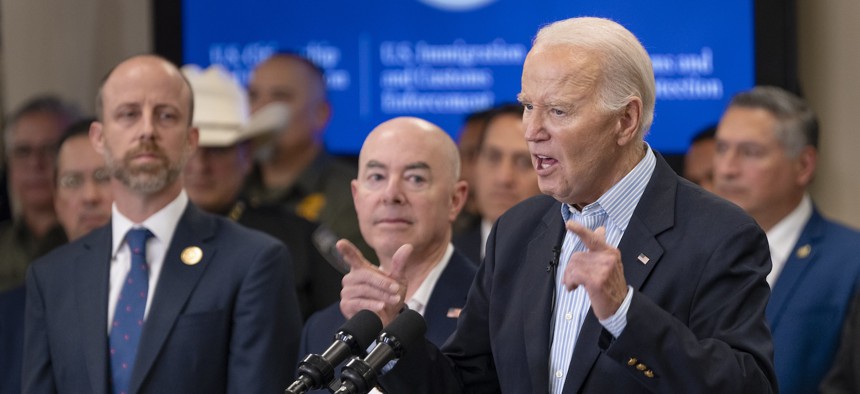
President Joe Biden speaks on immigration and border security at the Brownsville Station on February 29, 2024 in Olmito, Texas alongside DHS Secretary Alejandro Mayorkas (to Biden's right) and other officials. Cheney Orr/Getty Images
Tech questions at the border
Critics say the Customs and Border Protection app CBP One is glitchy and unfair to migrants.
More than 400,000 people have used Customs and Border Protection’s CBP One smartphone app to schedule an appointment at the southwestern border since its launch in 2020, according agency data.
The app is the portal to a variety of CBP services, but has drawn attention for its role in managing asylum requests near the U.S.-Mexico border.
Since May 2023, migrants in central and northern Mexico hoping to enter the U.S. without prior authorization are strongly encouraged to use CPB One to set up an appointment in advance at eight different ports of entry. If they forgo the app or a different legal pathway, they’re presumed ineligible for asylum, with limited exceptions, according to CBP.
The government says that the app has cut down on smugglers and represents the administration’s efforts to encourage the use of legal pathways.
“The CBP One app is just one example of how [the Office of Field Operations] is using innovative technologies to enhance the security and efficiency of processes at our ports of entry,” said Matthew Davies, executive director of CBP admissibility and passenger programs, at a September 2023 Senate hearing.
“People presenting themselves for asylum aren’t trying to evade border patrol,” Chris Cummiskey, a Department of Homeland Security senior official during the Obama administration and a former Arizona state senator, told Nextgov/FCW. “Now you have to process these folks. Once they’re processed, mechanisms are in place to help link them to a claims process.”
“My sense of it,” he added, “is that the folks that really want to go through the asylum process are interested in hitting marks and milestones. My recollection is that we were pretty high in terms of compliance.”
Bipartisan criticism
Controversy has surrounded CBP One since it launched, with allegations of glitchy tech and concerns about equity and privacy. Amnesty International has argued that the requirement, with limited exceptions, that migrants use the app to enter the U.S. in order to seek asylum violates international human rights law.
“The individuals that are seeking protection on the southwest border are extremely vulnerable and, for the most part, have come to seek asylum, which is the protection that people who have been persecuted in their home countries are able to access in the United States,” said Raul Pinto, deputy legal director for transparency at the American Immigration Council, which is tracking how CBP treats claims to exceptions and those who don’t use the app to get appointments at the border.
Some lawmakers have also raised concerns.
“The CBP One app is plagued with technical problems and privacy concerns, and it raises troubling issues of inequitable asylum access, including facial recognition software that misidentifies people of color,” Sen. Ed Markey, D-Mass., told Nextgov/FCW in a statement. Early last year, he asked DHS to stop using the app altogether.
In the House, over 30 Democrats expressed doubts about equity and accessibility of the app early last year, and “many of those concerns still stand, starting with the fact that many migrants don’t have access to a phone or cell service,” Rep. Jesús “Chuy” García, D-Ill., told Nextgov/FCW.
“The app still has serious issues with basic functionality, language access, and appointment capacity, and its shortcomings leave migrants vulnerable to smuggler scams and misinformation,” García said.
At the same time, some Republicans on Capitol Hill have criticized vetting processes for individuals using the app. House Homeland Security Committee Chair Mark Green, R-Tenn., said on Fox News in January that “the CBP One app is a shell game that just allows people to be processed more quickly into the country.”
How it works
To use the app, migrants must be located in central or northern Mexico and register through Login.gov, according to a May 2023 CBP presentation on the app. Login.gov is used for authentication but not identity proofing, says the General Services Administration, which houses the single-sign-on service.
The app — available in Spanish, Haitian Creole and other languages, as well as English — then guides users through a process to request an appointment. This includes allowing location permissions, registering travelers, and providing a selfie photo for identity verification, CBP says.
Registered individuals can ask for appointments daily. CBP says that some of the 1,450 daily appointments go to those who have been waiting longest, while the rest are allotted randomly. The appointments are for inspection, and those issued parole can later ask for asylum in immigration court.
The average wait time from initial requests to being seen at a port of entry is 8 weeks for non-Mexican users, a time in which people are generally making an appointment request daily, according to CBP — although NPR reported in February that some migrants at the border in Tijuana, Mexico are waiting as long as six months.
At the September hearing before the Homeland Security and Governmental Affairs Committee, Davies said that CBP has heard from agency officers that migrants have reported they don’t have access to a phone, encountered language programs with the app or were not aware of the process itself.
“We’re aware of some of these shortcomings,” he said. “To the ones we have the ability to address, we’re working to address with constant updates to the app.”
CBP provided some data and information regarding the app, but did not respond to a list of detailed questions from Nextgov/FCW for this story.
This article was adapted from a piece in the March 2024 print edition of Nextgov/FCW.
NEXT STORY: Ex-NSA innovation chief’s new startup looks to future-proof federal agencies against cyberthreats







